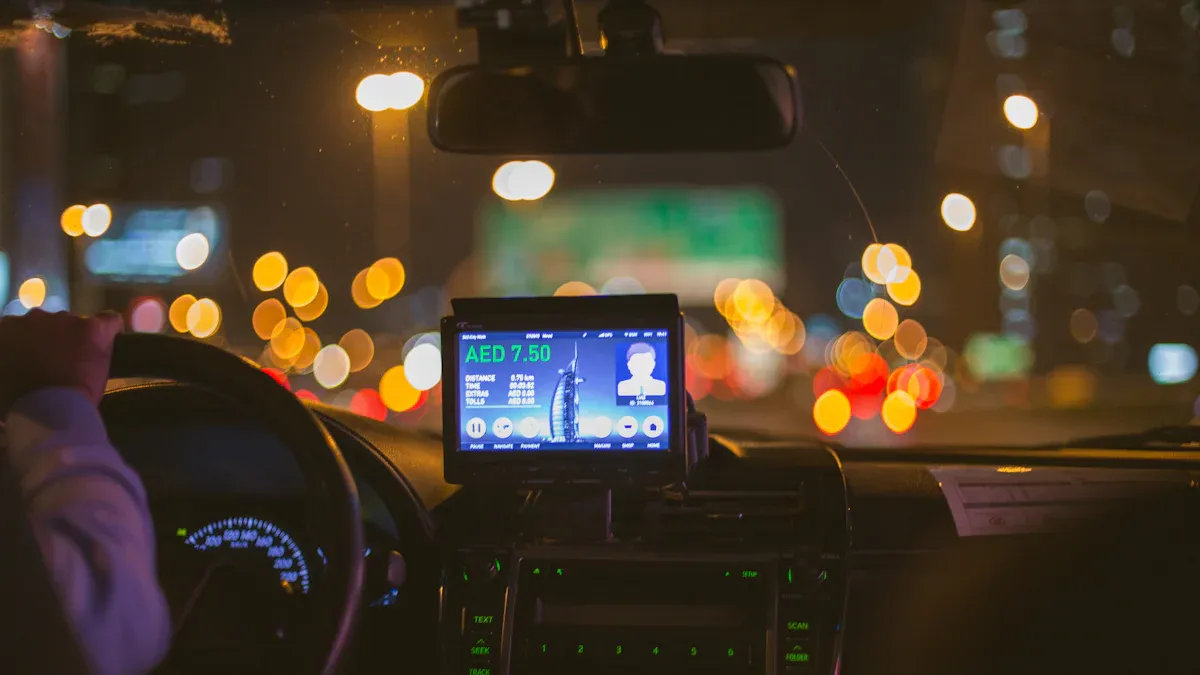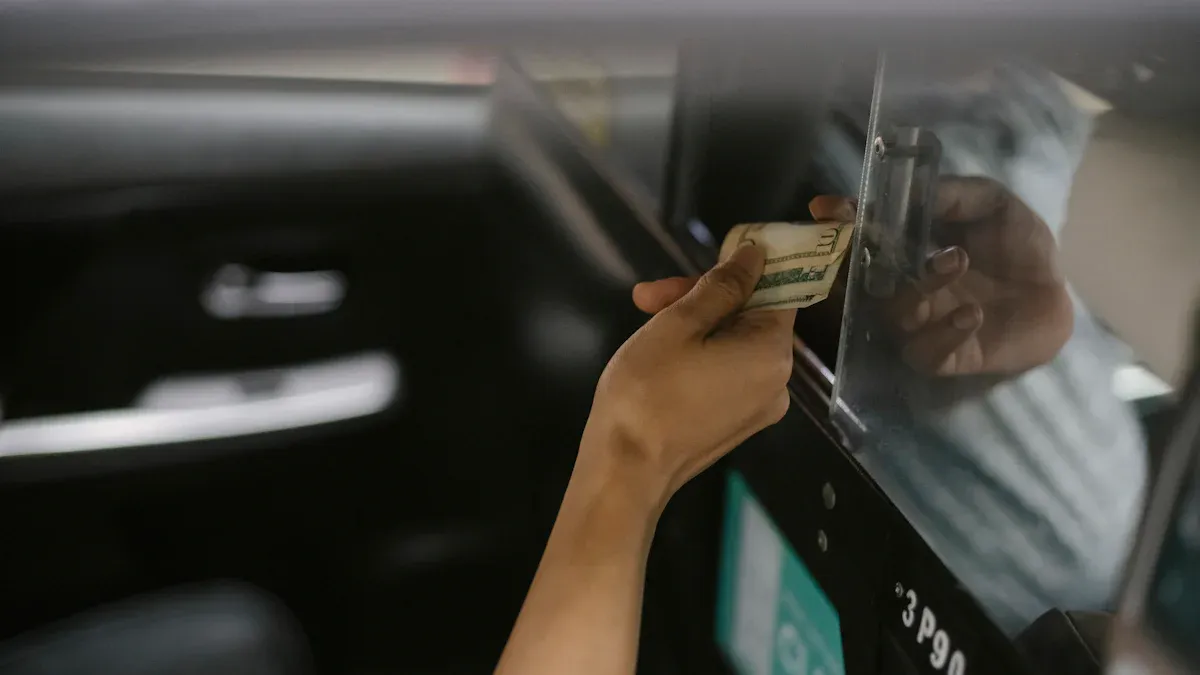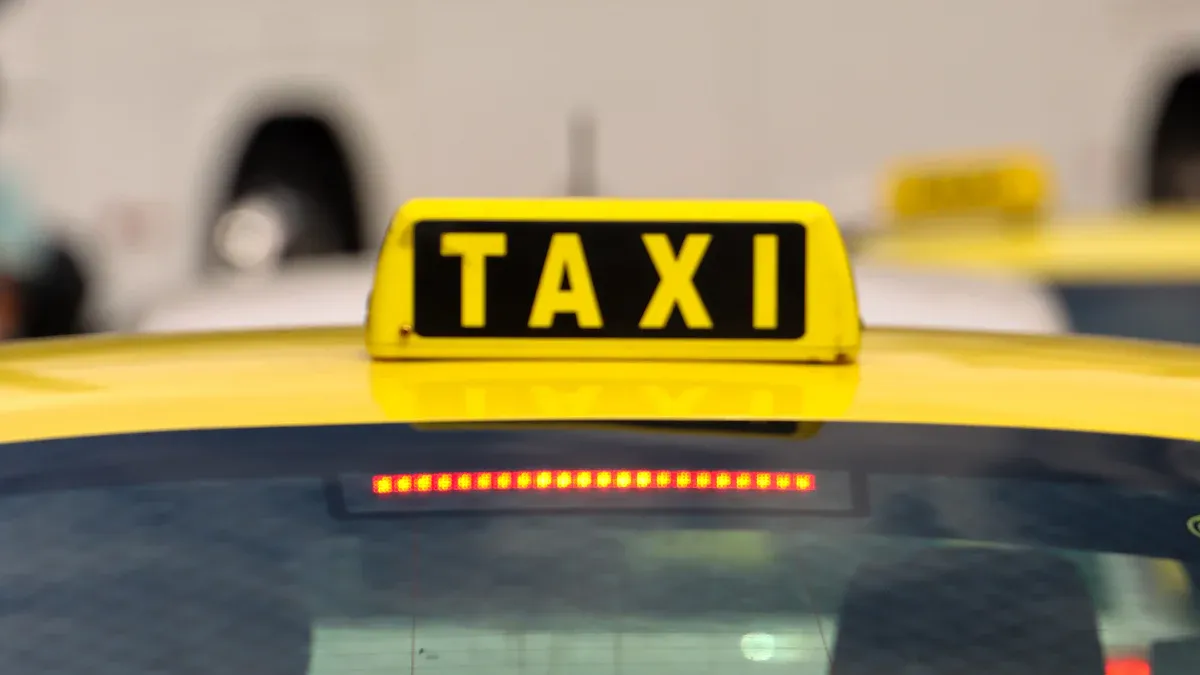
You notice in-taxi digital signage when you ride in a taxi. This technology uses screens to show ads and information while you travel. Companies use these displays to share offers and fun content based on your location. In-taxi digital signage makes your ride more interesting and helpful. Taxi owners can also make extra money because advertisers reach people during trips.
Key Takeaways
In-taxi digital signage has screens inside taxis. These screens show ads, news, and helpful info. The info can change with location and time.
The system has screens, media players, GPS, and software. These parts work together to give real-time, personal content.
Passengers get entertainment, local news, and safety tips. This makes rides more fun and helpful.
Advertisers reach the right people with changing ads. The ads can use videos or let people interact.
Taxi companies make extra money and control content from far away. They also make rides better with new technology.
In-Taxi Digital Signage Overview

What It Is
When you ride in a taxi, you might see screens inside. These screens show ads, news, and helpful tips while you travel. On-vehicle digital signage uses smart technology to match content to your location or the time. The content can change as the taxi moves to new places. This helps you stay entertained and learn new things during your trip.
On-vehicle digital signage is not just for riders. Advertisers use it to reach people while they travel. Taxi companies use these screens to earn more money and give a modern feel. The screens can show clear images, videos, and even let you interact. You get both fun and useful updates, making your ride better.
Tip: On-vehicle digital signage can show content in many languages. You might see English, French, Chinese, or others, depending on where you are.
Key Components
Every in-taxi digital signage system has important parts. Each part works together to show you the right content at the right time. Here are the main parts:
Screens: Most taxis have LCD or LED screens. Some screens face both inside and outside the taxi.
Media Players: These devices store and play digital content. They connect to the screens and control what you see.
Connectivity Modules: Wi-Fi, USB, GPS, and RJ45 ports help upload new content and track the taxi’s location. This lets on-vehicle digital signage show ads or updates based on where you are.
Content Management System (CMS): The CMS lets taxi operators control what shows on the screens. You get new and useful content because updates happen quickly.
Power Supply: The system uses the taxi’s battery. It has features to protect against power problems, so the screens work well during your ride.
Interactive Features: Some on-vehicle digital signage has touchscreens or QR codes. You can touch the screen, get more info, or play games.
Software: The software controls things like content timing and language. It can change what you see based on the taxi’s route using GPS.
Here is a table that shows how the market for in-taxi digital signage is growing:
Metric/Aspect | Details |
|---|---|
Market Size 2023 | |
Market Size 2024 | About $350 million |
Projected Market Size 2029 | About $700 million |
CAGR (Next 5 Years) | Expected between 12% and 15% |
Growth Drivers | More riders, better screens, more ride-sharing, targeted ads, Asia Pacific growth |
Segment Adoption | Started in luxury taxis, now in regular taxis |
Challenges | High starting costs, rules and laws |
Solutions to Challenges | New ways to pay, better data privacy |
Geographic Highlights | Fast growth in Asia Pacific, strong in North America and Europe |
Industry Trends | Ride-hailing app links, changing content, connected cars, new screen tech |
You can see that on-vehicle digital signage is growing quickly. The technology keeps getting better, and more taxis use these systems each year. You get better content, and advertisers reach more people. Digital screens in taxis now show clear images, videos, and even let you interact. This makes your ride more fun and helpful.
How In-Taxi Digital Signage Works
Hardware and Power
When you get in a taxi with on-vehicle digital signage, you will see screens on the seat backs or on the roof. These screens come in many sizes, like 7-inch, 10-inch, or 15-inch. Some taxis have roof LED panels, like P6 LED screens. These screens stay bright all day and night. Roof screens sit on rails and have strong covers to protect them from rain and bumps.
Inside the taxi, you see digital displays or tablets. These show videos, news, and coupons. The hardware uses mounts that stop shaking from hurting the screens. You do not have to worry about the screens turning off. The system connects to the taxi’s power, often through the car’s electric system or the cigarette lighter. This setup does not change the taxi’s wiring. The voltage is usually between 8V and 36V DC, which fits most cars. Power features, like break power memory, help the screens keep working if the taxi’s power stops for a moment.
Note: It is easy to install the screens. You can use brackets to put them on the headrest. You do not need special tools or to change the taxi.
Software and GPS
On-vehicle digital signage uses smart software to control what you see. Most systems use cloud content management platforms. Taxi operators can schedule, update, and control content from anywhere. Some popular software are DENEVA, Navori SA, Omnivex Corporation, OnSign TV, and LytAds. These platforms support real-time updates and can use AI to pick ads or messages.
GPS is important for showing the right content. The system uses GPS modules to know where the taxi is. This means you get information that matches your location. For example, if you are near a mall, the screen might show a store offer. The software can also use the time or weather to change what you see. This keeps your ride interesting and the information new.
Tip: GPS helps the system show ads and updates that fit your location. This makes the experience more personal and helpful.
Content Delivery
On-vehicle digital signage gives you new content in real time. The system connects to the internet with Wi-Fi, 4G SIM cards, or LAN cables. This strong connection lets the screens get updates fast. Taxi operators use a central content management system to send new ads, news, or videos to every taxi. You always see the latest information because the system updates by itself.
The content is not random. The system uses geolocation to show ads and info based on where the taxi is. For example, you might see a restaurant ad when you pass by. Advertisers can also change the content for the time, weather, or city events. Some screens let you touch the display or scan a QR code.
On-vehicle digital signage matches content to the taxi’s route and the people inside. Local businesses can show their services to passengers nearby. This helps advertisers reach the right people and gives you real-time info that matters during your trip.
Callout: Dynamic content and real-time info make your taxi ride more fun. You get updates that are timely, local, and sometimes fun to use.
Types of On-Vehicle Digital Signage

Seat-Back Screens
When you ride in a taxi, you often see seat-back screens right in front of you. These screens are a common form of on-vehicle digital signage. You can watch movies, play games, or listen to music. Some screens let you choose what you want to see, making your ride more fun. These digital screens also show ads that match your interests. You might see a restaurant ad if you are near a food area.
Seat-back screens help you stay informed with real-time updates and navigation tips. They can even dim automatically to keep the driver safe. Some systems use voice control, so you do not need to touch the screen. Taxi companies use these screens to earn extra money by showing targeted ads. You also get a better ride because the screens offer entertainment and useful information.
Tip: Seat-back screens can improve your experience and make your trip feel shorter.
Interactive Displays
Interactive displays take on-vehicle digital signage to the next level. You can touch the screen to play games, answer surveys, or get more details about an ad. These digital displays connect to your phone using Bluetooth or Wi-Fi. You might scan a QR code to join a contest or get a coupon.
These high-resolution displays use smart technology to show ads that fit your age or interests. Advertisers like these screens because you can interact with their content. When you play a game or give feedback, you help companies learn what you like. Taxi operators see more happy passengers and more repeat riders because of these engaging features.
Interactive displays make your ride more personal.
You can help shape the ads you see by giving feedback.
Roof-Mounted Screens
Roof-mounted screens are another popular type of on-vehicle digital signage. These high-resolution displays sit on top of the taxi and show bright, moving ads to people outside. You notice these digital screens when taxis drive by, especially at night. The display can change in real time, so ads match the area or time of day.
These screens work in all kinds of weather and temperatures. They use strong, waterproof covers and special power systems. Taxi companies can update the ads from far away using the internet. Roof-mounted screens help businesses reach many people across the city. The bright digital display stands out in busy streets and helps companies save money compared to old-style signs.
Note: Roof-mounted screens use GPS to show ads that fit the taxi’s location, making each ad more effective.
Advertising and Benefits
For Passengers
When you ride in a taxi with digital signage, you get more than just a ride. These screens give you real-time info and fun things to watch. This makes your trip smoother and more fun. Here are some main benefits you get:
You see updates about your route, traffic, or weather. This helps you know what is happening and feel sure about your trip.
The screens help you find your way around the city. This is great if you are new or do not travel often.
You can see info in many languages and styles. This helps everyone, even people with disabilities, enjoy the ride.
Entertainment and ads keep you busy. This makes the ride feel faster and less boring.
Safety tips and alerts show up right away. This helps you stay safe while you travel.
Tip: In-taxi digital signage helps you feel less lost and more relaxed by giving you the right info at the right time.
For Advertisers
Advertising inside a taxi lets brands reach people in a special way. You can use digital signage to show cool ads that get attention and make people want to join in. Here are some good things for advertisers:
You can change ads fast, based on where the taxi is or what time it is.
Digital screens let you use videos, moving pictures, and things people can touch. This makes ads easier to remember.
You save money because you do not have to print or put up new ads every time.
You can pick who sees your ads by choosing certain routes, times, or types of riders.
Taxi ads give you better info and numbers, so you know how many people see your ads and can make your ads better next time.
Bright screens and moving pictures help your brand stand out and be remembered.
Compared to Traditional Taxi Ads
Digital signage in taxis has more benefits than old taxi ads. Old taxi ads do not change and always look the same. With digital signage, you can show new ads that fit the place and time. This means you can run short ads or change them for local events.
People usually spend about 18 minutes in a taxi. This gives your ads lots of time to be seen. Studies show digital taxi ads are remembered more than old ads. People inside the taxi pay more attention, so they remember your brand better. You also get reports that show how your ads did, so you can make your next ads even better.
Digital Signage for Taxi Companies: Content Management
Content Creation
When you make content for digital signage in taxis, you want people to notice it fast. Use bright colors and big letters so it stands out. Keep your words short, with less than seven in each message. This helps riders read them quickly. Add things like QR codes or games to make ads more fun. You can also link your ads to social media or use touch screens for more ways to interact.
Here are some good tips to follow: 1. Make ads with things people can use, like games or QR codes. 2. Use strong pictures and only a few words so it is easy to read. 3. Decide what you want each ad to do, like tell people about your brand or show a special deal. 4. Pick taxi routes that will show your ads to the right people. 5. Check how well your ads work by counting QR code scans or how many people use your deals.
You can make templates for taxi cab digital signage to save time. Templates help you keep your ads new and make changes easier. Work with your creative team early so your ads look good and match your goals.
Tip: Change your ads often to keep up with trends and keep riders interested.
Scheduling and Updates
You need to change your digital signage content often so passengers stay interested. News, weather, and deals should change every day. Other things, like company news or product info, can change every week or month. Use a content management system to plan and set up these changes. CMS tools let you plan when to show things, group screens by where they are, and use live updates.
Plan changes ahead for holidays or special days.
Use content libraries and templates to make planning faster.
Set up automatic updates to save time and keep things the same.
A good CMS helps you see which ads work best. You can find out what passengers like and change your plan to get better results.
Remote Management
Remote management lets you control all your taxi screens from one place. You can watch devices, send updates, and fix problems without going to each taxi. This saves time and money. If a screen turns off or loses power, you can restart it from far away. You also keep your ads safe and running, which helps your business make more money.
Remote management tools let you: – Add new devices all at once. – Update apps and security settings from your office. – Lock screens after work to save battery. – Watch screens in real time and fix problems fast.
With remote management, your digital signage network works well. You also make it safer and make sure your ads always reach people.
In-taxi digital signage makes taxi rides more fun and useful. You see content that is just for you and always up to date. This keeps you entertained and helps you know what is happening. Advertisers can show their ads to many people and check how well they do.
You get news, local deals, and things you can touch or use. These features make every ride better.
Advertisers use smart tools to send the right ads to you. They can also see if their ads work well.
Taxi companies use digital signage to give better service. They also earn more money from ads.
As cities get bigger and technology gets better, digital signage in taxis will help you even more.
FAQ
What can you see on in-taxi digital signage?
You can see ads, news, weather updates, and local deals. Some screens show games or let you interact. The content often changes based on your location or the time of day.
Is in-taxi digital signage safe for your privacy?
Most systems protect your privacy. They do not collect personal details. Some may use general data like your location to show better ads. You can ask the driver if you have concerns.
Can you turn off the screen if you do not want to watch?
Some taxis let you lower the volume or dim the screen. You may not always turn it off completely. If the screen bothers you, ask the driver for help.
How do advertisers know which ads to show you?
Advertisers use GPS and time data to pick ads. For example, you might see a restaurant ad when you pass by a food area. The system does not use your personal information.
See Also
How A CarPlay Dongle Makes Driving Easier And Safer
Best Wireless CarPlay Dongles Compatible With Ford Fiesta
Best HDMI Dongles For 4K CarPlay Streaming In 2025
